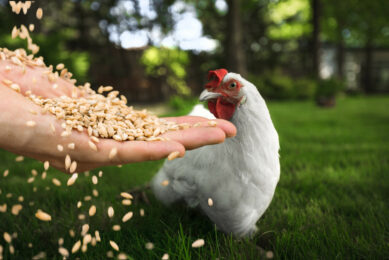Seven key barriers in feeding the world

Feeding the world offers many opportunities. However, increasing production is challenging. Experts identified seven key barriers which impede the ability to feed nine billion people. Collected under the acronym GLIMPSE, Alltech gave a glimpse of the future.
By Fabian Brockötter
We all have our greatness and it’s a question of awakening it. A leader’s only job is to help others awaken their greatness. Create the space for people to flourish. Don’t try to get it right, get it going.” Dr Pearse Lyons, president and founder of Alltech started off the annual symposium by challenging the current and future leaders in the 2,400 strong crowd to find their passion and use it to lead and to inspire others. The success of his own company as well as the whole agricultural sector is not only wishful, but outright indispensable for the near future. Lyons believes that there are plenty of opportunities in feeding a growing world population, but there are barriers in place. He put the spotlight on the theme ‘Glimpse of the future’, based on research done by Alltech’s vice president Aidan Connolly. Combining a literature review and interviews with a panel of 24 agribusiness experts, Connolly framed the obstacles and identified the opportunities for future growth. An important step towards harnessing the power of the marketplace so that the agricultural sector can bring together creativity, determination and technology to bear on the challenge of feeding the billions of additional people that will join the world by 2050. “We in agriculture must think differently from how we have in the past, by adopting new technology at a faster pace and communicating in a way we never have before. We must find the balance for sustainable food production and protection of resources while satisfying consumer demands,” Lyons stated.
Wicked problem
The challenge of feeding another three billion people within the next 40 years meets the definition of a ‘wicked
problem’, especially because time is running out. It has been assumed that “solving” agricultural challenges is the role of governments, NGO’s, the United Nations and charities. Indeed NGO’s, the UN and numerous charities are all doing substantive, important work, but the last 40 years has demonstrated the limitations of institutional approaches. Moreover, the solutions that emerge from conventional thought processes are unwieldy and often unrealistic.
To make things worse, agribusiness has been seen by some as part of the problem, pursuing short-term gains at the expense of human development and the environment. A misconception according to Connolly: “The agribusiness expertise could prove to be valuable, it is part of the solution. The private sector has really come to grasp its responsibility about sustainable production. They realise that it’s not just about profits and it’s not just about keeping shareholders happy. It’s really about having a license to produce and being acceptable in society and investing in the long term.” That said, there are inevitable barriers that have to be overcome and which will take maximum engagement of the agricultural sector.
Glimpse
Collected under the acronym GLIMPSE, the main challenges and opportunities were put in a framework. Behind the word ‘Glimpse’ Alltech implies the main aspects: G for government, L for loss in food and ingredient supply chain, I for infrastructure, M for markets, P for politics and policies, S for science and innovation, and E for environment. The expert panel interviewed by Connolly et al. named the governments as the biggest barrier. Bureaucracy, policies, regulations and – in some places – endemic corruption are in the way of growth and efficiency by limiting cross-border food trade. The second character in the acronym refers to the fact that one-third of food produced is lost or wasted in production, processing, distribution and use. In low-income regions the loss is largely due to harvesting techniques, poor post-harvest storage, packaging and marketing. In higher income regions the loss is at the consumption stage: food that is still fit for consumption is discarded.
Partly this ties in with the third barrier; infrastructure. A good infrastructure is essential for the condition in which a product arrives and also improves the competitiveness of exporting countries.
Supply volatility
Barrier 4, the markets, demonstrate how ‘wicked’ the problem of feeding the world is. Volatility of supply and demand is often exacerbated by policies, and aggravated by opaque pricing mechanisms. Barriers to investment for marginal cost suppliers are linked to market volatility as well as government and policy interference. Moving beyond bureaucracy, there is the challenge of policies (barrier 5) that support wasteful use of resources or subsidised environmentally destructive practices. Subsidies on the ‘wrong’ crops in the ‘wrong’ places, biofuel promotion and import bans play a significant role in market inefficiency.
The level of accepting the end products of science and innovation due in part to environmental and humanitarian concerns, is lagging behind. Nobel Laureate Norman E. Borlaug once noted: “…the sceptics and critics of the new biotechnology wish to postpone the release of improved crop varieties in the hope that another year’s, or another decade’s, worth of testing will offer more data, more familiarity, more comfort. But more than a half-century in the agricultural sciences has convinced me that we should use the best that is at hand, while recognising its imperfections and limitations. Far more often than not, this philosophy has worked, in spite of constant pessimism and scare-mongering by critics.” That leads almost automatically to the last barrier, the environment. According to the United Nations, agriculture has to produce more per unit of land, water and agrochemicals, because resources are scarce.
Crucial role
Agribusinesses can anticipate, recognise and work to overcome government bureaucracy and corruption. It can build credibility with consumers by being more open about the science of innovation and also by working to help shape policy in ways that are constructive to the larger goals, not simply narrow self-interest. By taking a long-term perspective, and developing working relationships across boundaries, agribusinesses can help reduce losses, by bringing supply chain expertise to areas where it is less developed and by helping with efforts to improve infrastructure. The environmental challenges will also require a long-term perspective to repair, protect and develop land and water resources. Working with government and policy makers will be an important part of meeting the environmental challenges, of developing the necessary infrastructure and helping to ensure that markets are fair and open. However, all of these factors are reliant on having the people to carry them out.
Lyons concluded the symposium by challenging the delegates to help the farmer of tomorrow, to use the resources provided to them within the Glimpse framework and to search out opportunities to make an impact in the agribusiness industry.
Lyons: “We live in ‘the era of you’, an era in which unprecedented control over the future of the world rests in the hands of the people. An era of connection, rapid change and re-invention in which old technologies are rapidly replaced and industries shift according to what consumers want. You may not rule the world, but you can have an impact on feeding the world’s growing population.”
AllAboutFeed 21.8











